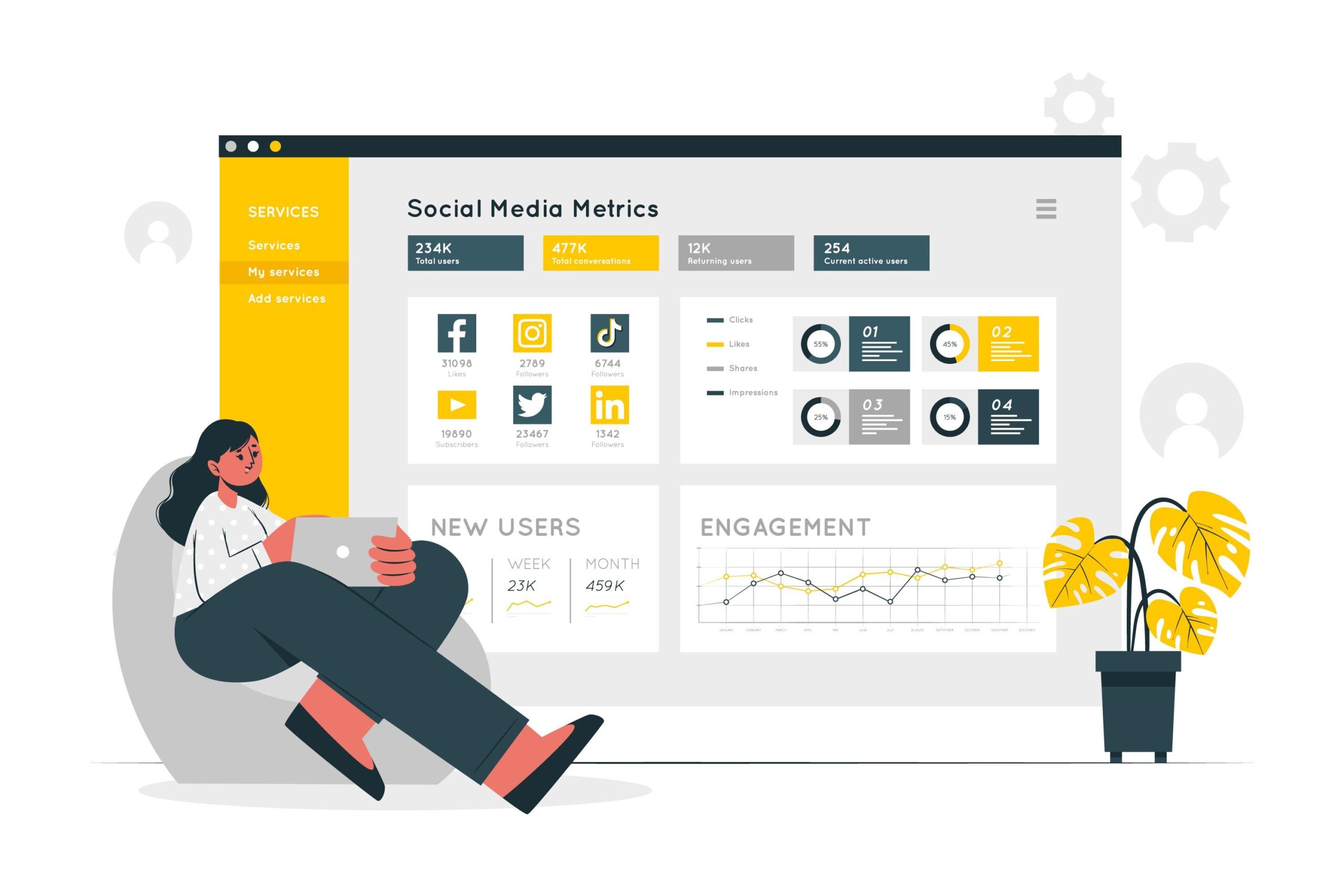
Introduction
Definition of Social Media Analytics
Collecting, analyzing, and interpreting data from social media platforms to learn about the efficacy of social media marketing strategies is known as social media analytics. Measuring the success of social media campaigns requires keeping tabs on a number of different indicators, such as the number of interactions, the number of people reached, and the number of people who converted.
Importance of Measuring the Success of Social Media Marketing Campaigns
In today’s digital world, businesses of all sizes have realized the need of incorporating social media into their marketing plans. Many people use social media, and businesses may connect with potential clients instantly through these networks.
However, it is essential for firms to evaluate the efficacy of their social media advertising strategies before devoting additional money. Businesses risk wasting time, effort, and money on ineffective marketing techniques if they lack access to reliable social media analytics in order to ascertain whether or not their social media marketing campaign is yielding the desired results.
As a result, businesses can’t succeed in marketing or acquire a competitive edge without social media analytics. Key KPIs for social media analytics will be discussed in the next section.
Key Metrics for Social Media Analytics
Reach
The reach of your social media posts is the total number of people who have viewed them. It reveals how many people your work has actually reached and its overall size. Businesses need to know how many people they are truly reaching with their social media initiatives, and reach is a crucial measure for doing so.
Engagement
The level of engagement with your social media material is a key indicator of its success. User interaction such as liking, commenting, sharing, etc. An increase in engagement rates suggests that your audience is finding value in your posts and is more inclined to take some sort of action as a result.
Impressions
The number of times your social media post has been viewed by readers is measured in “impressions.” As opposed to reaching, impressions are tallied whenever your content is viewed by anyone. Businesses can use the number of impressions to gauge the popularity of their content and learn more about how well it is received.
Click-Through Rates
The percentage of people that clicked on your content and were taken to a new page shows how effective your marketing campaign was. This indicator shows how well your CTA is doing and shows organizations what types of content are bringing in the most visitors.
Conversions
How many people took the required action after watching your social media post is measured in terms of conversions. One example is completing a form, another is buying something, and yet another is signing up for a newsletter. The ROI of a company’s marketing efforts may be calculated and the success of social media initiatives can be determined by monitoring conversion rates.
Brand Mentions
The number of times your brand has been discussed in the conversation online. Interaction with your brand in the form of a mention, tag, or reference in a public post. Companies may learn a lot about their internet reputation and the success of their marketing activities by keeping tabs on how often and where their brand name is mentioned.
Sentiment Analysis
Sentiment analysis is a method for assessing the overarching tone of online discussions pertaining to your company’s brand. It entails assessing the positivity, negativity, or neutrality of social media mentions based on the aforementioned factors.
To keep their online reputations in good standing, businesses can use sentiment analysis to learn where they can make changes and how to handle unfavorable comments.
Next, we’ll look at some specific social media analytics tools.
Tools for Social Media Analytics
Social Media Platforms Insights
Most social media platforms have built-in analytics tools that organizations may use to track their social media success. These tools provide deep insights into numerous metrics like reach, engagement, impressions, and clicks.
For example, Facebook Insights provides granular statistics on post-performance, audience demographics, and page views. Instagram Insights, on the other hand, provides information about followers, impressions, reach, and engagement rates. Twitter Analytics gives information regarding tweet impressions, engagements, and audience demographics. Using social media platform insights is a straightforward and cost-effective way for organizations to get started with social media analytics.
Third-Party Analytics Tools
In addition to social media platform data, organizations can also employ third-party analytics tools to track their social media success. These tools provide more extensive statistics and insights on social media indicators.
Examples of popular third-party analytics platforms are Hootsuite, Sprout Social, and Buffer. These programs provide a range of functions such as social media scheduling, content preparation, and social media monitoring. They also offer in-depth analytics and reporting, making it easier for organizations to track their social media performance across numerous platforms.
Google Analytics
Google Analytics is a free analytics tool that organizations may use to measure website traffic and social media referrals. It provides deep insights into user behavior, including how users interact with social media material on the website. By monitoring these referrals, businesses may learn which social media channels are most effective in bringing customers to their site and where they can make the most progress.
Social Listening Tools
In order to keep tabs on their brands’ mentions in social media, firms might use social listening tools. By monitoring online conversations about their brand, businesses can learn to address any issues that customers may have. Brandwatch, Mention, and Sprout Social are all examples of social listening software. Businesses can learn a lot about their target demographic and how to better reach them by listening in on social media conversations.
How to interpret social media numbers is the topic of the next section.
How to Analyze Social Media Metrics
Set Measurable Goals
Establishing quantifiable objectives is the starting point for any social media analytics project. In order to be effective, these objectives need to be SMART (specific, measurable, attainable, relevant, and time-bound). For the next six months, for instance, the company may aim to raise its social media engagement rate by 10%. A company’s social media efforts can be monitored and evaluated more effectively if specific objectives are established.
Track Metrics Over Time
Once measurable targets have been established, it is crucial to monitor progress over time. Businesses may see if their social media strategies are successful or not by keeping close tabs on key performance indicators and reacting quickly to any changes. A company’s social media strategy should change with the seasons, and tracking analytics throughout time might help with that.
Compare Metrics with Industry Benchmarks
Social media analytics should be compared to industry benchmarks in order to ascertain how well a company is doing in relation to its rivals. Social media measurements can be better understood and used by organizations when compared to industry norms. If a company’s engagement rate is 5% but the average in its industry is 10%, the company knows it needs to raise its rate in order to compete.
Recognize Trends and Patterns
Metrics collected from social media platforms can be analyzed to reveal useful trends and patterns for organizations. Some companies may find that their engagement rates are higher at specific times of day or weeks of the year. The success of a company’s social media marketing efforts can be enhanced by the detection of trends and patterns.
Determine Effective Methods and Strategies
Successful social media campaigns and strategies can be uncovered by analyzing relevant indicators. Businesses may get the most out of their social media marketing efforts by studying the results and then using those findings to inform future strategies. If a company’s Instagram Stories campaign did well, for instance, that data can be used to improve future efforts.
Let Metrics Guide Your Future Plans
Finally, businesses should use social media indicators to guide their actions in the future. Metrics gathered from social media platforms allow organizations to fine-tune their approach to this marketing channel. If a company’s Facebook engagement rate is low, for instance, it may decide to devote more resources to producing interesting content or raising its advertising expenditure on the platform.
Conclusion
Businesses need social media analytics to evaluate their campaigns. Businesses may improve their social media effectiveness by tracking reach, engagement, impressions, click-through rates, conversions, brand mentions, and sentiment analysis.
Social media analytics tools include platform insights, third-party analytics, Google Analytics, and social listening tools. By employing these tools, organizations may monitor social media metrics and make data-driven decisions regarding their social media campaigns.
Businesses should define quantifiable goals, track metrics over time, compare data with industry benchmarks, uncover patterns and trends, identify successful campaigns and methods, and use analytics to influence future plans to evaluate social media metrics.
Social media analytics helps firms optimize their social media campaigns and reach their marketing goals. Social media analytics gives organizations a competitive edge and long-term success.





